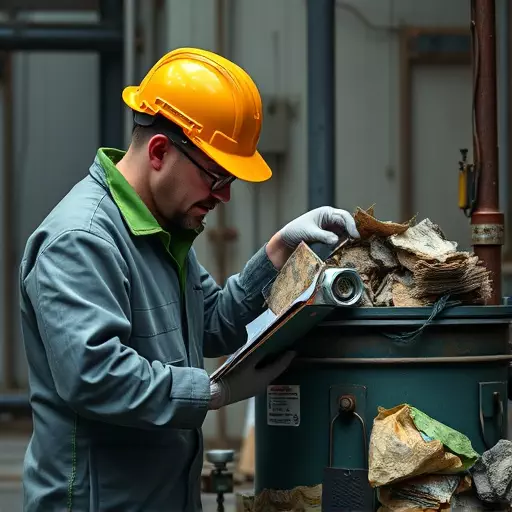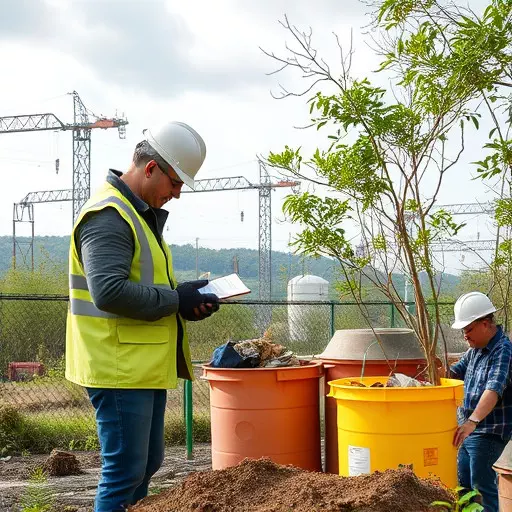Understanding stormwater management is crucial for minimizing environmental impact and ensuring compliance with diverse local, state, and federal regulations, especially concerning hazardous waste. Key strategies include implementing best management practices (BMPs) like proper drainage systems and regular maintenance to reduce sediment and chemical run-off. Environmental compliance inspections are vital for assessing properties' adherence to these regulations, preventing contamination, and fostering sustainable practices. Stormwater audits delve into detailed assessments of handling, treatment, and discharge processes, focusing on BMPs and hazardous waste management protocols. Regular inspections track changes over time, facilitating continuous improvement in stormwater quality and environmental protection. Staying updated with environmental regulatory frameworks and implementing tailored solutions after audits is essential for proactive risk mitigation, promoting environmental stewardship, and avoiding penalties during inspections.
In today’s digital era, effective stormwater management is not just an environmental imperative but a key component of urban sustainability. Stormwater management audits play a pivotal role in ensuring environmental compliance, identifying vulnerabilities, and driving continuous improvement. This comprehensive guide explores the intricate world of these audits, delving into their function as powerful tools for navigating complex environmental regulatory frameworks and mitigating risks associated with hazardous waste management. From understanding the basics to best practices, this article equips readers with insights for achieving exceptional stormwater stewardship.
- Understanding Stormwater Management: A Brief Overview
- The Role of Audits in Environmental Compliance Inspection
- Key Components of an Effective Stormwater Audit
- Navigating Environmental Regulatory Frameworks for Stormwater
- Identifying and Mitigating Risks During Hazardous Waste Management Audits
- Best Practices for Post-Audit Implementation and Future Compliance
Understanding Stormwater Management: A Brief Overview

Understanding Stormwater Management involves recognizing its critical role in minimizing environmental impact and ensuring compliance with regulatory frameworks. Stormwater, a natural resource that can carry pollutants, needs careful management to prevent water quality degradation and protect ecosystems. Effective strategies include implementing best management practices (BMPs) like proper drainage systems, permeable surfaces, and regular maintenance to reduce sediment and chemical run-off.
A key component of this process is the environmental compliance inspection, which assesses a property’s adherence to local, state, and federal environmental regulatory frameworks. These audits are particularly important for facilities that handle hazardous waste, as they ensure proper disposal methods and prevent potential contamination. By integrating these measures, communities can foster sustainable stormwater management practices while adhering to stringent environmental standards.
The Role of Audits in Environmental Compliance Inspection

Stormwater management audits play a pivotal role in ensuring environmental compliance within various industries. These rigorous inspections serve as a critical tool to assess and verify that facilities are adhering to established environmental regulatory frameworks, particularly those related to hazardous waste management. By conducting thorough audits, experts can identify potential violations or non-compliance issues that may go unnoticed otherwise.
During an environmental compliance inspection, auditors meticulously examine stormwater management systems, including collection, treatment, and discharge processes. They verify the proper implementation of best management practices (BMPs) designed to minimize pollution from industrial activities. A hazardous waste management audit is a specific component focusing on the safe handling, storage, and disposal of toxic substances, ensuring they don’t contaminate surrounding water bodies via stormwater runoff.
Key Components of an Effective Stormwater Audit

An effective stormwater audit is a multifaceted process that aligns with environmental regulatory frameworks and ensures adherence to strict environmental compliance inspection standards. Key components include a thorough assessment of the site’s stormwater management systems, such as catchbasins, retention ponds, and filtration systems. Auditors must meticulously evaluate the design, installation, and maintenance of these systems to confirm they meet designated water quality standards.
Furthermore, a comprehensive audit delves into potential sources of pollution within the vicinity, identifying practices that may contribute to stormwater contamination. This involves scrutinizing hazardous waste management protocols, ensuring proper containment and disposal methods to prevent toxic substances from entering the stormwater runoff. Regular inspections and documentation are vital to track changes over time and facilitate continuous improvement in stormwater quality and environmental protection.
Navigating Environmental Regulatory Frameworks for Stormwater

Navigating Environmental Regulatory Frameworks for Stormwater is a complex yet essential task for any organization or municipality aiming to maintain environmental compliance. These frameworks, designed to protect natural resources and human health, encompass a wide range of regulations covering water quality, pollution control, and hazardous waste management. An environmental compliance inspection often serves as a critical tool to assess these aspects, identifying potential non-compliance issues that may require immediate attention.
For effective stormwater management, understanding and adhering to these regulatory standards are paramount. Organizations must ensure their practices align with local, state, and federal guidelines, which can vary significantly in scope and stringency. A thorough hazardous waste management audit, for instance, is crucial to identify and mitigate risks associated with the generation, handling, and disposal of potentially harmful substances within stormwater systems. This proactive approach not only avoids legal repercussions but also fosters sustainable practices, contributing to a healthier environment and more resilient communities.
Identifying and Mitigating Risks During Hazardous Waste Management Audits

During stormwater management audits, identifying and mitigating risks associated with hazardous waste is paramount to ensuring environmental compliance. These audits, guided by environmental regulatory frameworks, meticulously scrutinize how facilities handle and dispose of potentially dangerous substances. By pinpointing vulnerabilities in hazard mitigation strategies, auditors can recommend targeted solutions to minimize ecological impacts.
Effective risk mitigation involves implementing best practices such as proper storage, containment, and disposal protocols. Regular training for staff on hazardous waste handling procedures and staying abreast of evolving environmental regulatory frameworks are also crucial. This proactive approach not only fosters environmental stewardship but also helps facilities avoid costly penalties associated with non-compliance during these inspections.
Best Practices for Post-Audit Implementation and Future Compliance

After completing a stormwater management audit, implementing best practices for post-audit actions is vital to ensure long-term environmental compliance and responsible water resource stewardship. One key practice involves developing an action plan based on the audit findings, prioritizing areas that require improvement and setting realistic goals. This proactive approach helps organizations address potential non-compliance issues before they escalate, reducing the risk of penalties and legal repercussions.
Additionally, staying informed about relevant environmental regulatory frameworks is essential for future compliance. Regularly reviewing and updating stormwater management practices to align with the latest guidelines and standards ensures that operations remain sustainable and legally sound. Incorporating training programs for staff on hazardous waste management audit protocols further reinforces a culture of accountability and proactive environmental stewardship.


